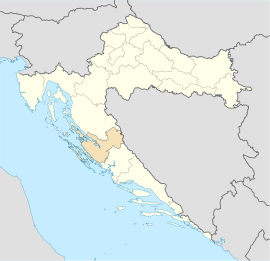Obrovac (Croatia)
| Obrovac | ||
|
||
|
|
||
| Basic data | ||
|---|---|---|
| State : |
|
|
| County : |
|
|
| Residents : | 4,323 (2011) | |
| Telephone code : | (+385) 023 | |
| Postal code : | 23 450 | |
| License plate : | ZD | |
| Structure and administration (status: 2013, cf. ) |
||
| Community type : | city | |
| Mayor : | Ante Župan ( HDZ ) | |
| Postal address : | Obala kralja Dmitra Zvonimira 2 23 450 Obrovac |
|
| Website : | ||
Obrovac ( Italian Obrovazzo ) is a town in northern Dalmatia in the Zadar County in Croatia . The city is located in the canyon of the Zrmanja River .
history
In the 10 . and 11 . In the 19th century, Croatian rulers held sovereignty over the city. In 1102 Croatia and with it Obrovac came to Hungary through an agreement in personal union. From the 12th century on, the Obrovac region fought frequent battles with Venice . Here in 1118 the troops of the Hungarian King Stephen II defeated the Venetians and Ordelafo Faliero , the doge of Venice, found his death in front of the city. In 1202 Obrovac was conquered by the Venetians with the help of the French .
The Venetian and Croatian-Hungarian rule changed now. After several uprisings, Obrovac and Zadar came into the possession of the Hungarian-Croatian King Ludwig I (Peace of Zadar, 1358). After his death, King Sigismund ruled, then Ladislaus of Naples, pretender to the Hungarian crown. In 1409 he sold his rights to Dalmatia to Venice for 100,000 ducats .
After the fall of Venice, Obrovac and northern Dalmatia came to Austria-Hungary . After the First World War , the city became part of the Kingdom of Serbs, Croats and Slovenes ,
From 1945 Obrovac was in the Socialist Republic of Croatia , a Yugoslav republic.
Obrovac has been part of the Zadar County since 1991 .
In the course of the Croatian War in 1991 Obrovac became part of the territory of the Republic of Serbian Krajina controlled by Croatian Serbs . The Škabrnja massacre took place around 5 km from Obrovac in the same year. In the course of the military operation Oluja , in August 1995, Obrovac was captured and reintegrated into Croatia.
According to the 2011 census, 65.72% of the inhabitants of the municipality are Croats and 31.44% Serbs . At the 1991 census, the proportion of the Serbian population was 66%. In the village itself, which after Kruševo (with 93% Croats) formed the second largest settlement in the municipality, the Serbs were represented with 75%.
tourism
The ruins of the old fortress have been preserved above the city. The city is known to fans of rafting and kayaking .
gallery
|
City entrance |
The bridge on the Zrmanja river |
Ruins of the fortress above the city |
Individual evidence
- ↑ Yugoslavija | Hrvatska enciklopedija. Retrieved September 7, 2017 .





